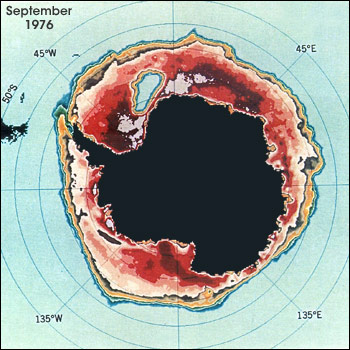In 1974, just a couple years after the launch of the first Landsat satellite, scientists noticed something odd in the Weddell Sea near Antarctica. There was a large ice-free area, called a polynya, in the middle of the ice pack. The polynya, which covered an area as large as New Zealand, reappeared in the winters of 1975 and 1976 but has not been seen since.
Scientists interpreted the polynya’s disappearance as a sign that its formation was a naturally rare event. But researchers reporting in Nature Climate Change disagree, saying that the polynya’s appearance used to be far more common and that climate change is now suppressing its formation.
What’s more, the polynya’s absence could have implications for the vast conveyor belt of ocean currents that move heat around the globe.

Satellite imagery allowed scientists to find an ice-free area in the Weddell Sea (upper left quadrant) in the Antarctic winters of 1974 through 1976. (Credit: Claire Parkinson (NASA GSFC))
Surface seawater around the poles tends to be relatively fresh due to precipitation and the fact that sea ice melts into it, which makes it very cold. As a result, below the surface is a layer of slightly warmer and more saline water not infiltrated by melting ice and precipitation. This higher salinity makes it denser than water at the surface. Read more

